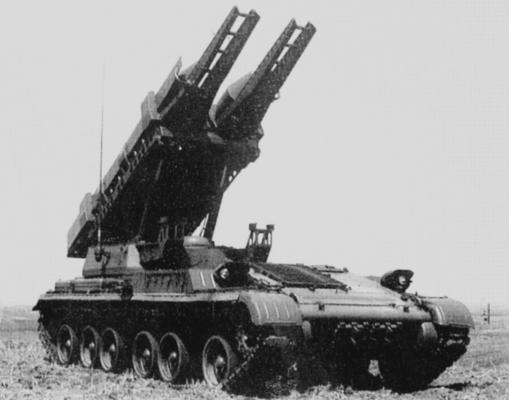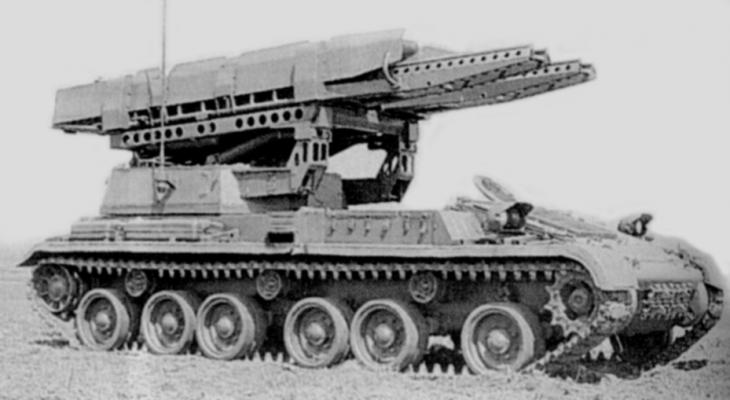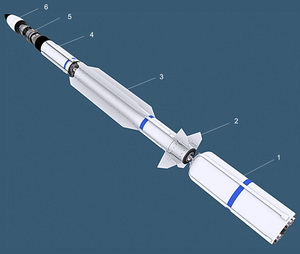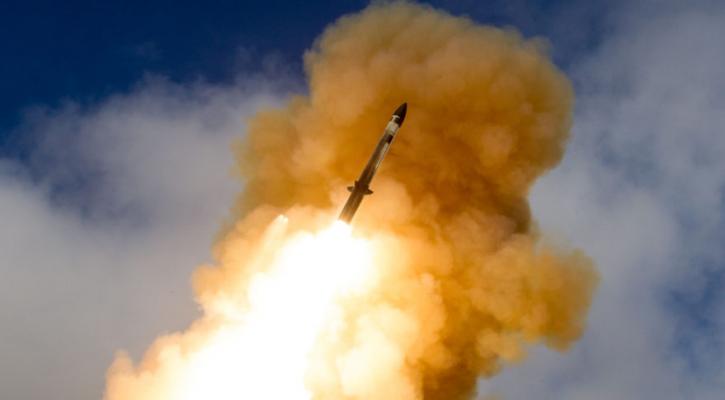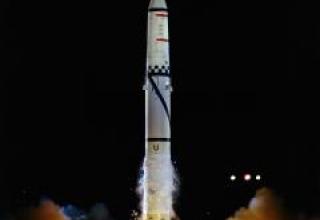The Type 762 remote demining system is the largest of the remote demining reactive systems developed by NORINCO (China North Industries Corporation).
The guide package consists of two guideways. It is mounted on a cradle assembly mounted on the rear part of the modified track vehicle chassis, which is similar to the chassis of Type 83 self-propelled howitzer gun for firing 152 mm caliber rounds. The driver's seat is located at the front of the hull on the left side with the power pack including engine, transmission and cooling system on the right. The combat vehicle is equipped with Type 803 hydraulic system, Type 803 selector coupling system, Type 889 radio station, Type WG002 panoramic sight, Type WG002 0.5 stereo optical rangefinder and Type TYG-1 night vision equipment for driver mechanics. The PM is also equipped with a 7.62mm machine gun and several fire sockets on both sides and at the rear (where the exit) to provide defense in case of need. The machine gun can be mounted on an anti-aircraft tripod.
The machine gun can be fired with a 129 kg solid propellant rocket engine, stabilized by the plumage, and can be fired with a 425 mm remote-controlled projectile. The head units are equipped with containers with a volume detonation mixture of at least two pieces, which detonate creates excessive pressure, thus ensuring the cleaning of the minefield. The weight of the head unit is 621 kg, the launching weight of the missile is 760±5 kg, the maximum flight range is 800-1000 m. The missile's maximum flight speed is 98 m/sec and its minimum flight speed is 31 m/sec. The length of the missile is 4700 mm. As a result of detonation of one missile is cleaned passage length of 130 m and a width of 12 to 22 m.
Charging of projectiles is carried out by means of an onboard crane (photo).
The cost of a combat vehicle without unguided rockets as of 2001 was $868,000.
Production is likely to have been completed in the mid-90s. It has never been exported. It is in service with the People's Liberation Army of China. 277 combat vehicles assembled.
Manufacturers of the system were Chinese military-industrial complex enterprises, NORINCO concern.
Composition:
The missile defense complex includes:
- AEGIS Combat Control System:
- radar AN/SPY-1D(V);
- fire control system Mk 99;
- a ship-wide computer system with 24 AN/UYK-7 and AN/UYK-20 computers;
- display devices like AN/UYK-4 (or AN/UYQ-21);
- 4 indicators of generalized tactical situation;
- hydroacoustic complex;
- radio electronic system on board the helicopter;
- digital LINK-11 communication lines;
- E-2S Hawkeye long-range radar observation and control deck aircrafts, S-3 Viking anti-submarine deck aircrafts and Orion base patrol R-ZS.
- SM-3 missile (RIM-161)
- Vertical Launching Unit (VLU) Mk41;
SM-3 has the same mass dimensional characteristics as SM-2 Block IV. The length of both rockets is 6.59 m, the diameter of the accelerator - 533 mm, the diameter of the march stage - 343 mm, mass - 1500 kg. Both missiles are equipped with the same solid-fuel accelerator Mk 72 with a four-nozzle block, acceleration and marching two-mode engines Mk 104, wings of ultra-small elongation and opening block of aerodynamic rudders.
The difference between SM-2 and SM-3 is the installation of a third stage on SM-3, which includes:
- precoaster motor Mk 136,
- inertial guidance section with GPS receiver and data exchange line,
- lightweight dumpable fairing,
- Intercept stage Mk 142, which destroys the target by direct hit.
The Ìk 136 is a solid fuel double-start motor developed by Alliant Techsystems. It is equipped with two solid fuel charges separated by a barrier system, and its design is made of graphite epoxy and carbon-carbon composite materials. The engine run time is 30 seconds. To ensure stabilization and orientation of the third stage of the rocket during the autonomous flight, the engine includes an integrated control system that uses cold gas as a working body.
The Mk 142 intercept stage is a self-propelled device with a cryogenic IR-GSN matrix, several processors, a solid fuel propulsion system for maneuvering and orientation (DACS), a power supply and a number of other subsystems on board.
Advertising in the initial stages of the work, Raytheon reported that the range of infrared GHN target detection is more than 300 km, and the use of DACS allows you to deflect the trajectory of its flight at a distance of more than 3-3.2 km.
The creation of such a small-size propulsion system was one of the results of a program launched in the mid-1980s to implement critical missile defense technologies. At that time a number of leading American companies were involved in its implementation on a competitive basis. As a result, by the early 1990s Boeing, the leader in this work, had created the "lightest in the world" (weighing less than 5 kg) propulsion system. It consists of a solid fuel gas generator equipped with several charges, a nozzle block and high-speed (up to 200 Hz) valves, capable of operating at a temperature of 2040 ° C. As noted, the creation of such a design required the use of special heat-resistant materials, in particular, based on rhenium.
SM-3 is launched from the Mk41 vertical starter, designed for ships equipped with the Aegis system.
Work was carried out to adapt SM-3 rockets for use with ground-based launchers. This version of SM-3 was first proposed by Raytheon in 2003 and was initially developed on a proactive basis. As an option, the developer company proposes integrating the ground-based SM-3 into the THAAD missile defense system.
SM-3 Block IA
The first variant of SM-3 missile modernization was SM-3 Block IA, which had small improvements in the design of the intercept stage. Flight tests of SM-3 Block IA began on June 22, 2006, during which a number of successful ballistic target intercepts were performed at various points in the trajectory. In addition to the U.S. Navy ships equipped with the Aegis system, a number of these tests involved Japanese, Dutch, and Spanish ships.
The "standard" range and intercept altitude of SM-3 Block IA are reported to be 600 and 160 km, respectively, with a maximum speed of 3-3.5 km/s, which provides the kinetic impact energy of an intercept stage with a target of 125-130 mJ.
In February 2008, after appropriate preparation, this version of the missile was used to destroy the American satellite USA-193 at 247 km altitude.
In February 2013, the SM-3 Block IA interceptor missile launched from the USS Lake Erie cruiser destroyed a target simulating a medium-range ballistic missile. An external target designation from the STSS-D (Space Tracking and Surveillance System-Demonstrators) satellite was used.
SM-3 Block IB
In the development of the next option - SM-3 Block IB - along with American firms, a number of Japanese firms are involved in this work in accordance with the agreement concluded in August 1999 between the governments of the United States and Japan.
The main differences between SM-3 Block IB and Block IA relate to the intercept stage. The SM-3 Block IB missile uses a new 10-nozzle DACS, which is capable of changing the traction value, and a two-color IR-GSN, which increases the size of the target detection area and improves its detection against interference. CCTV is equipped with reflective optics and advanced signal processor, which allows you to intercept targets at ranges greater than previous versions.
SM-3 Block IIА
According to the agreement signed between the US and Japan, radical improvement of SM-3 has been underway since 2004. The development of this option, designated SM-3 Block IIA, began in 2006. The main external difference of the new variant will be that the missile diameter along the entire length will be 533 mm - the maximum allowed by the installation of vertical launch Mk 41 and, therefore, does not require special carrier ships for its location.
The missiles are equipped with a stage of intercept of the increased diameter, improved IR-GSN and more efficient propulsion system maneuvering and orientation TDACS (Throttleable Divert and Attitude Control System) kinetic warhead.
Aerojet's new TDACS (Trottleable Divert and Attitude Control System) solid fuel system with adjustable thrust will provide spatial movement as well as control of roll, yaw and pitch angles during the process of pointing the kinetic warhead at the target in the overatmospheric section of the trajectory. General Dynamics has developed the key technology for a miniature, high-precision throttle control system. The solutions and processes previously developed in the SM-3 Block I versions were widely used in the development.
SM-3 Block IIA will feature a new nose fairing and smaller aerodynamic surfaces.
The use of a large-size acceleration and marching engine as part of SM-3 Block IIA will provide an increase in the final speed of the missile by 45-60%, or up to 4.3-5.6 km/s (so this option is also called High Velocity), and a range of up to 1000 km. In turn, increasing the missile's size will lead to a more than one-and-a-half-fold increase in its launch weight.
The full development cost of SM-3 Block IIA could be $3.1 billion. (The cost of the first missile samples up to $37 million), and it may also include a number of works previously performed by the Agency for Defense under the program to create a miniature intercept stage MKV (Miniature Kinetic Vehicle), which will compete with the currently being developed for the promising variants of SM-3 stage intercept UKV (Unitary Kinetic Vehicle).
The first launch of SM-3 Block IIA is expected in 2014. If the tests are successful, rapid deployment of these missiles will begin in 2015 and full-scale deployment in 2018.
SM-3 Block IIB
In 2011, Lockheed Martin reported that the U.S. Missile Defense Agency awarded it a $43.3 million contract to develop the SM-3 Block IIB missile concept.
The plans for the SM-3 Block IIB further enhance its performance by installing an oversized intercept stage (UKV), which has better target acquisition and detection performance, as well as the ability to maneuver aggressively at the end site (High Divert). The new generation missile will provide early intercept capability for long-range ballistic missiles and will be integrated with the Aegis BMD 5.1 control system.
The SM-3 Block IIB will also utilize remote targeting technology, which will include not only target designation from remote radars and control systems, but also the ability to update target data during flight from other systems, including unmanned aircraft equipped with onboard multispectral targeting systems.
Further plans envisage that by 2020 it will be possible to equip SM-3 Block IIB with several stages of MKV intercept, the mass and size of which will allow to place up to five such vehicles on board. The introduction of such enhancements will make it possible to consider SM-3 Block IIB as an interceptor with ICBMs and their warheads in exoatmospheric flight paths.
Characteristics:
| Technical specifications of the combat vehicle | |
| Length in hiking position, mm | 7162 |
| Length by body, mm | 6405 |
| Width in hiking position, mm | 3236 |
| Height in hiking position, mm | 3200 |
| Battle weight, kg | 27 000 |
| Maximum travel speed, km/h: on paved roads over rough terrain |
10–32 |
| Overcoming slope, %, ° | 60, 25 |
| Lift override, %, ° | 40, 31 |
| Height of the wall to be overcome, mm | 700 |
| The depth of the ford to be overcome, mm | 1300 |
| Overcoming ditch, mm | 2700 |
| Ground pressure, kg/cm2 | 0,62 |
| Calculation, man. | 4 |
| Number of guides, pcs. | 2 |
| Angle of elevation, deg: | |
| minimum | +5 |
| maximum | +45 |
| Angle of horizontal fire, deg.: | |
| to the right of the chassis axle | 90 |
| to the left of the chassis axle | 90 |
| Chassis Specifications | |
| Engine | |
| Power per unit weight, HP/T | 19,3 |
| Power System | |
| Maximum power reserve, km | 450 |
| Chassis | |
| Track width, mm | 2620 |
| Supporting track length, mm | 4601 |
Testing:
It is alleged that two projectiles were launched towards the Israeli capital, the city of Tel Aviv, from Gaza on the evening of 15 November 2012.
The Palestinian terrorist organization Al-Quds Brigades, the militant wing of the Islamic Jihad, claimed responsibility for the shelling. According to their statement, two Fadjr-5 rockets were fired towards Tel Aviv, indicating that the group had hundreds of such rockets.
Sources:
1. Forecast International. – August 2001.
2. Jane’s Ammunition Handbook 2000-2001. – P.636.
3. Jane’s Armour and Artillery 1991-92. – P.692.
4. Jane’s Armour and Artillery 2000-2001. – P.758-759.
5. Jane’s Armour and Artillery 2005-2006. – Раздел Multiple Rocket Launchers. China. NORINCO 425 mm Type 762 (2-round) mineclearing rocket system.
